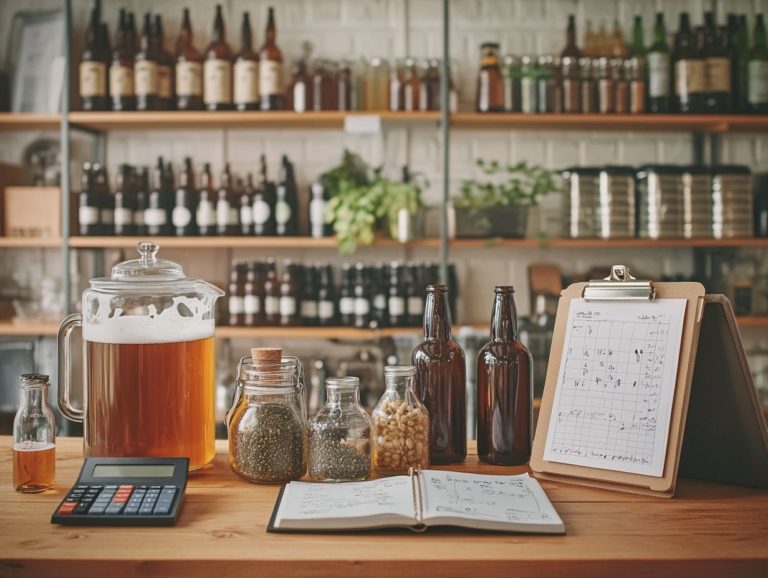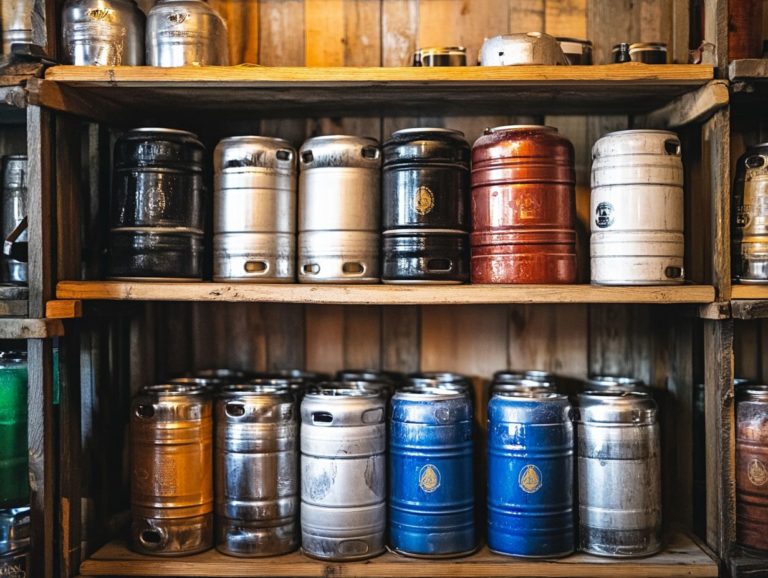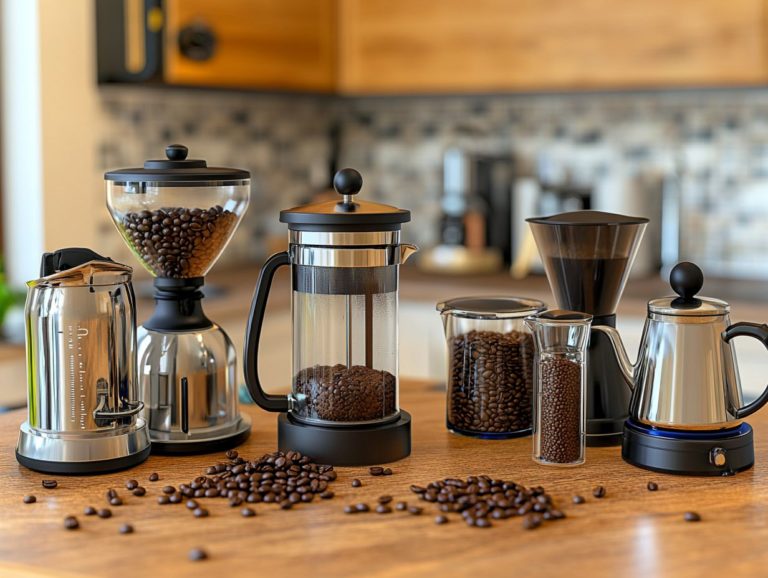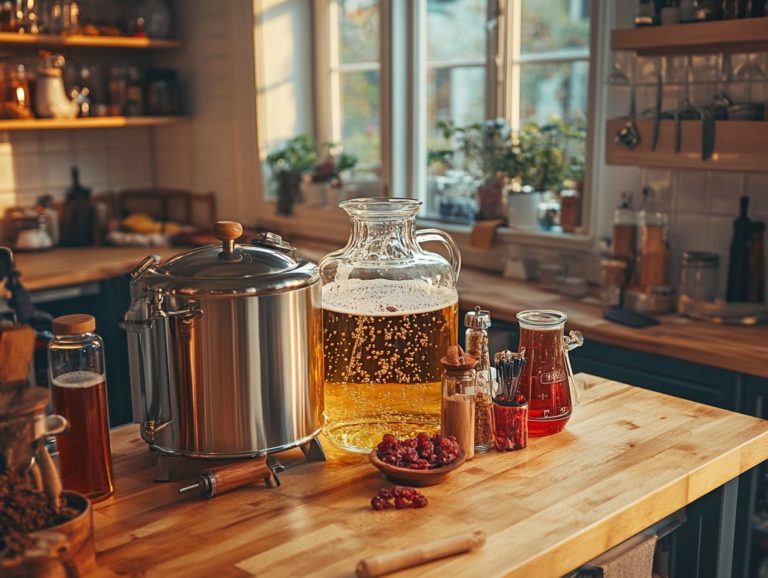How Do I Create My Own Beer Recipe?
Creating your own beer recipe is an exhilarating journey, brimming with creativity and the thrill of flavor exploration, especially within the homebrewing community.
At the core of every exceptional brew lie a few essential ingredients: malt, hops, yeast, and water, each contributing to various beer styles. Each element plays a crucial role in shaping the beer’s character, influencing everything from its taste to its aroma.
This guide helps you select the right malt and hops, choose the perfect yeast, adjust your water chemistry, and consider vital factors such as style guidelines and flavor profiles.
Whether you re a newcomer to brewing or a seasoned expert, these insights will empower you to craft a beer that genuinely embodies your unique vision, avoiding common brewing mistakes.
Contents
- Key Takeaways:
- 3. Yeast
- 4. Water
- How Do You Choose the Right Malt for Your Beer Recipe?
- 1. Base Malts
- What Types of Hops Should You Use in Your Beer Recipe?
- How to Select the Right Yeast for Your Beer Recipe?
- 3. Specialty Yeast
- What Factors Should You Consider When Creating a Beer Recipe?
- 1. Style Guidelines
- 2. Flavor Profile
- Frequently Asked Questions
- What is the first step to creating my own beer recipe?
- What ingredients do I need to create my own beer recipe?
- How do I determine the right ratios of ingredients for my beer recipe?
- Do I need any special equipment to create my own beer recipe?
- How long does it take to create my own beer recipe?
- Can I experiment with different ingredients in my beer recipe?
Key Takeaways:
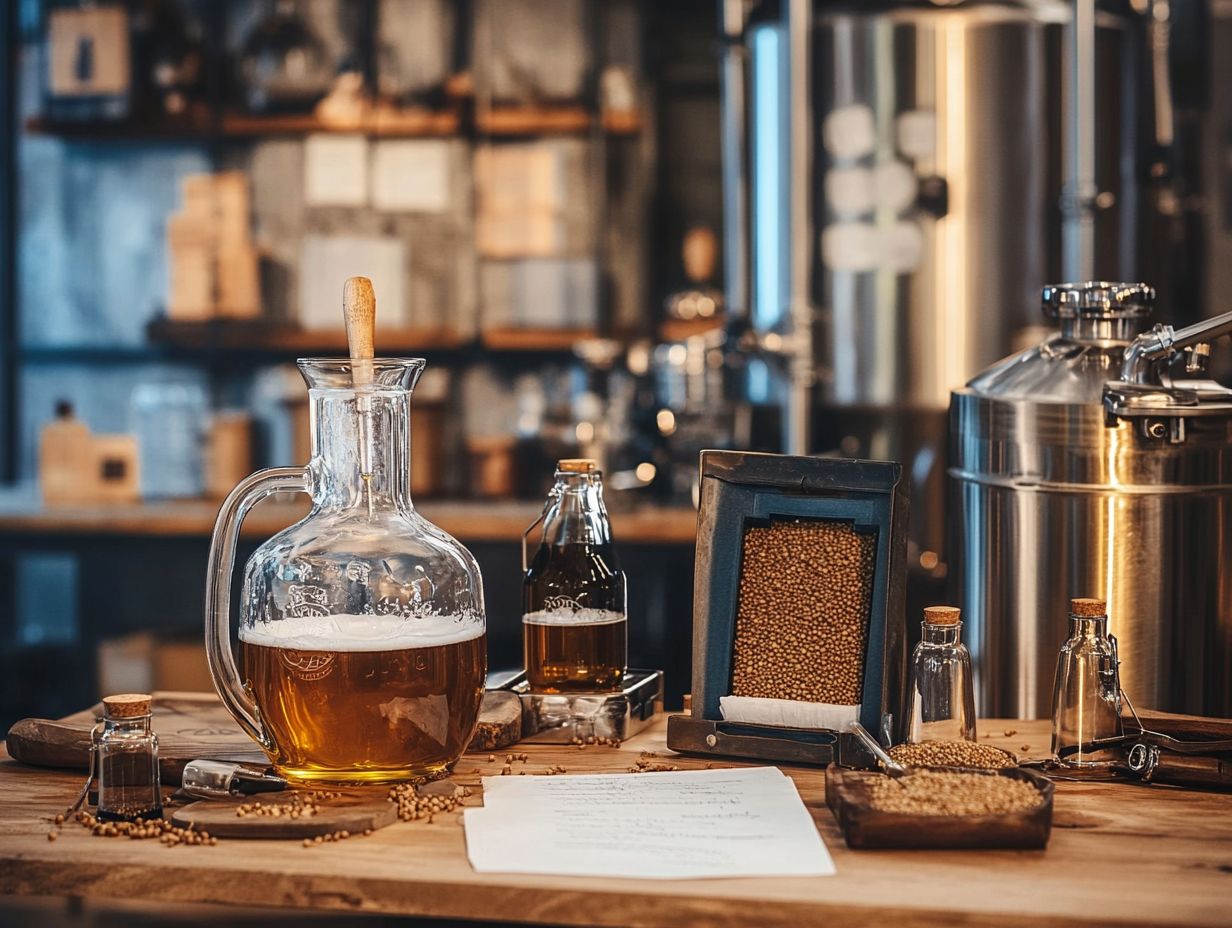
- Act now: Choose the right ingredients for your beer recipe: malt, hops, yeast, and water are essential for quality ingredients.
- Consider different types of malt for your recipe, including base, specialty, and roasted malts. Utilize brewing books to gain more insights.
- Use a variety of hops for bitterness, flavor, and aroma in your beer recipe, utilizing different hop techniques for optimal balance.
What Are the Basic Ingredients for a Beer Recipe?
Understanding the key ingredients for a beer recipe is crucial for you as a homebrewer aspiring to create high-quality brews. The four fundamental components malt, hops, yeast, and water each play a significant role in the brewing process and ultimately shape the characteristics of your beer.
Malt supplies the sugars necessary for fermentation, while hops introduce bitterness and unique flavors that define the beer’s overall taste profile. Yeast is crucial for fermentation, converting those sugars into alcohol, and the chemistry of your water can greatly influence both flavor and brewing efficiency, impacting the beer’s character.
When combined, these ingredients form a sturdy foundation on which you can craft a variety of beer styles, each with its own unique flair.
1. Malt
Malt stands as one of the essential ingredients in beer, delivering the crucial sugars needed for fermentation while also shaping the beer’s flavor profile and overall character.
Grasping the different types of malt can significantly elevate your brewing experience, especially when using brewing tips and brewing software. Pale malt commonly serves as the foundation for many beers, presenting a light, crisp backdrop that allows other flavors to shine in creative brewing. In contrast, chocolate malt infuses rich notes of chocolate and coffee, enriching the beer s complexity and deepening its color.
Roasted barley, a staple in stouts, imparts a bold bitterness and dark hue that many enthusiasts crave, contributing to specific beer styles. Specialty grains let brewers create unique recipes. These grains bring unique flavors and aromas, encouraging you to experiment for that perfect taste.
2. Hops
Hops are renowned for delivering the essential bitterness, flavor, and aroma that elevate your final brew.
- Bittering hops, typically added early in the boil, provide the crucial bitterness that balances the sweetness of the malt.
- Flavor hops enhance the taste profile of your beer, often introduced during the later stages of the boil to add complexity without overwhelming bitterness.
- Aroma hops are added at the end of the boil or even during fermentation to infuse your creation with vibrant, fragrant notes that can define its character.
By employing different hop techniques and timing, you can skillfully manipulate the bitterness and flavor balance, crafting a rich tapestry of unique flavors that cater to a wide range of beer styles.
3. Yeast
Yeast plays a pivotal role in your brewing process, acting as the driving force behind fermentation the process where yeast converts sugars into alcohol and the creation of alcohol. It also shapes the character and flavor profile of your beer, influenced by fermentation temperature.
Your choice of yeast can dramatically influence the taste, aroma, and overall quality of the final product. Different strains exhibit unique fermentation behaviors, producing varying levels of esters and phenols that impart distinct flavors, from fruity to spicy notes.
Fermentation temperature is another crucial factor you should consider, as it directly impacts yeast activity and the resulting beer profile, including carbonation levels. High temperatures may lead to more pronounced estery flavors, while lower temperatures can yield a clean, crisp taste.
By understanding the various fermentation processes, including primary and secondary fermentation, you can craft an impressive range of beer styles from hoppy IPAs to rich stouts. Each benefits from your careful selection of the right yeast strain tailored to specific recipes.
4. Water
Water is often an overlooked ingredient in your brewing endeavors. Yet, it plays an essential role in both the quality and taste of your beer, significantly influencing the entire brewing process and brewing efficiency.
The mineral content and pH levels of your water can profoundly impact the efficiency of your brewing and the final flavor profile of your beer. For example, water rich in certain minerals can enhance the extraction of sugars from the malt. Maintaining proper pH levels ensures optimal enzyme activity during mashing.
If you re a homebrewer aiming for specific beer styles, adjusting your water chemistry can make a big difference! Consider traditional profiles known for amplifying desired flavor characteristics think hoppy brightness in IPAs or the velvety smoothness in stouts.
Grasping the importance of quality water will help you elevate your craft and create remarkably balanced brews that truly stand out.
How Do You Choose the Right Malt for Your Beer Recipe?
Choosing the right malt for your beer recipe is an essential step that can significantly shape the flavor, color, and aroma of your final product. With a diverse array of malts at your disposal, it’s important to grasp the distinct roles of base malts, specialty malts, and roasted malts.
Base malts are your primary source of fermentable sugars, while specialty and roasted malts add unique flavors and hues to your beer. By selecting the right malts, you not only enhance the character of your brew but also elevate your brewing efficiency and overall quality.
1. Base Malts
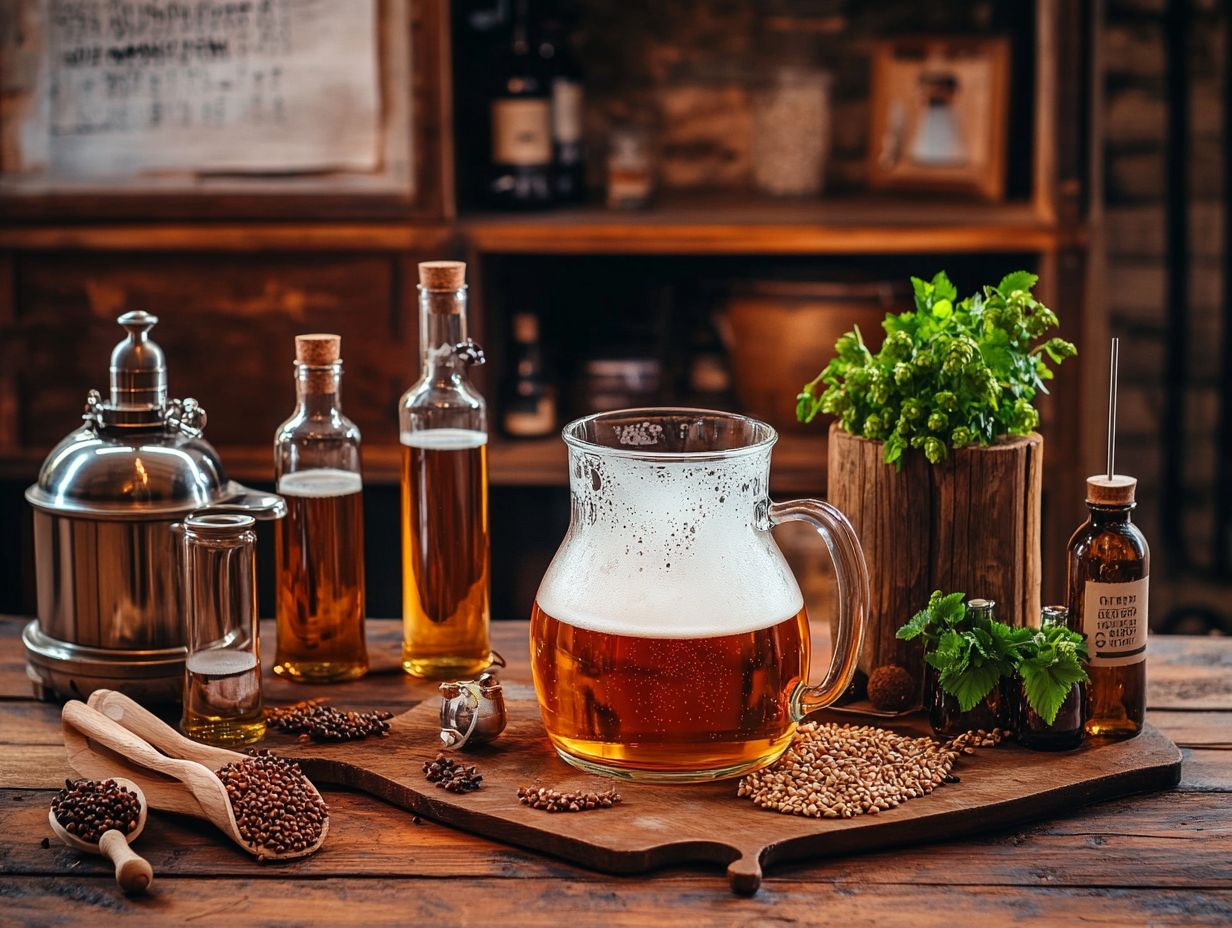
Base malts are the cornerstone of most beer recipes, supplying the essential fermentable sugars needed for fermentation. These base malts, especially pale malt, play a pivotal role in shaping not just the alcohol content but also the flavor profile and mouthfeel of the finished product.
Take pale malt, for instance; it imparts a light, bready character that acts as a canvas for other ingredients to layer their magic upon. Different base malts bring their own unique contributions, introducing varying levels of sweetness, acidity, and color, which can significantly influence the overall style of the beer.
Beyond pale malt, you have options like Munich or Vienna malt that can add richness and graininess, altering fermentation rates and enhancing the complexity of aromas and flavors. Thus, having a solid understanding of these ingredients is crucial for anyone looking to master the art of crafting specific beer styles.
2. Specialty Malts
Specialty malts are your secret weapon for infusing unique flavors and characteristics into your beer, elevating its complexity and overall profile.
These malts come in various types, each offering unique notes that can transform a standard brew into something extraordinary. For instance, caramel malts bring a delightful sweetness and a rich, toffee-like flavor, perfectly enhancing the body of a brown ale. Roasted malts deliver dark chocolate or coffee profiles, essential for stouts and porters, crafting the rich, deep flavors that define these beloved styles.
Munich malts contribute a robust, malty backbone, ideal for lagers and amber ales seeking a fuller flavor experience.
By leveraging the capabilities of these specialty malts, you can experiment with your recipes, creating unique and memorable beers that truly showcase the depth and versatility of malted grains, often used in craft breweries.
3. Roasted Malts
Roasted malts play a pivotal role in brewing, offering a deep color and rich flavors that are essential for many dark beer styles. These malts are typically derived from barley that has been roasted at high temperatures, resulting in a delightful spectrum of complex flavors, from chocolate and coffee to caramel and toffee.
When you incorporate roasted malts into your brewing recipes, you not only enhance the visual allure of the beer but also elevate its aroma and taste profile, enriching the beer design.
Styles like stouts and porters prominently showcase these malts, delivering bold flavors that might include notes of dark chocolate or roasted coffee, creating a truly well-rounded sensory experience.
You can also blend different types of roasted malts to achieve the desired intensity and flavor complexity, highlighting their versatility in various brewing techniques. Embracing these malts allows you to craft exceptional brews that tantalize the palate and leave a lasting impression.
What Types of Hops Should You Use in Your Beer Recipe?
Choosing the right hops for your beer recipe is essential to crafting the perfect brew, as they are pivotal in shaping the flavor, aroma, and bitterness you desire.
Hops fall into three primary categories: bittering hops, flavor hops, and aroma hops, each fulfilling a unique role in the brewing process. You ll typically add bittering hops early in the boil to impart bitterness, while flavor hops come into play later to deliver specific taste profiles.
For the finishing touch, aroma hops are added at the end of the boil or during fermentation, elevating the aromatic qualities of your beer. This careful orchestration creates a harmonious balance of distinct flavors that align beautifully with your selected beer style.
1. Bittering Hops
Bittering hops are your go-to ingredients early in the brewing process, expertly imparting the necessary bitterness to your beer, which is quantified in International Bitterness Units (IBU).
These hops are essential for balancing the sweetness of the malt, ensuring that your final product boasts a well-rounded flavor profile. The timing of their addition is crucial; typically introduced during the initial stages of the boil, bittering hops undergo a chemical transformation that amplifies their bitter potential.
You ll find different hop varieties, such as Cascade, Chinook, and Magnum, each offering unique characteristics that influence not just bitterness, but also aroma and flavor. As you increase the IBU level, how bitter a beer tastes can greatly change your drinking experience, especially in styles like IPAs and stouts, where achieving a harmonious balance between bitterness and sweetness is key.
2. Flavor Hops
Flavor hops are introduced later in the brewing process to impart distinctive taste notes that enhance the overall profile of your beer.
These hops are essential in shaping the character of your brew, offering an enticing array of aromas and flavors that can range from fruity and floral to earthy and spicy. As a brewmaster, you carefully select hop varieties that complement your recipes, timing their addition to maximize their impact.
For instance, you might reach for Citra hops, celebrated for their bright citrus notes, or Cascade hops, which deliver a harmonious balance of grapefruit and floral characteristics.
Beer styles like IPAs and pale ales prominently feature these flavor hops, creating bold and exciting tasting experiences that thrill your palate!
Why not experiment with some of these hop varieties in your next brew? Your taste buds will thank you!
3. Aroma Hops
Aroma hops are typically added at the end of the brewing process or during fermentation, significantly enhancing the aromatic qualities of the beer. This critical step delivers a delightful burst of fragrance and shapes your entire tasting experience.
The interaction of these hops with malt and yeast crafts a complex symphony of aromas that can range from floral and citrusy to earthy and spicy. Brewers often employ various techniques, such as dry hopping or hop bursting, to maximize these aromatic effects.
You might find popular hop varieties like Citra, Mosaic, and Saaz infused into a pale ale or IPA, delivering vibrant notes of grapefruit and pine. Meanwhile, styles like Belgian ales may showcase Saaz hops, introducing subtle herbal undertones.
Ultimately, the right use of aroma hops can elevate a brew from the ordinary to the extraordinary, enriching not only your sense of smell but also your entire palate.
How to Select the Right Yeast for Your Beer Recipe?
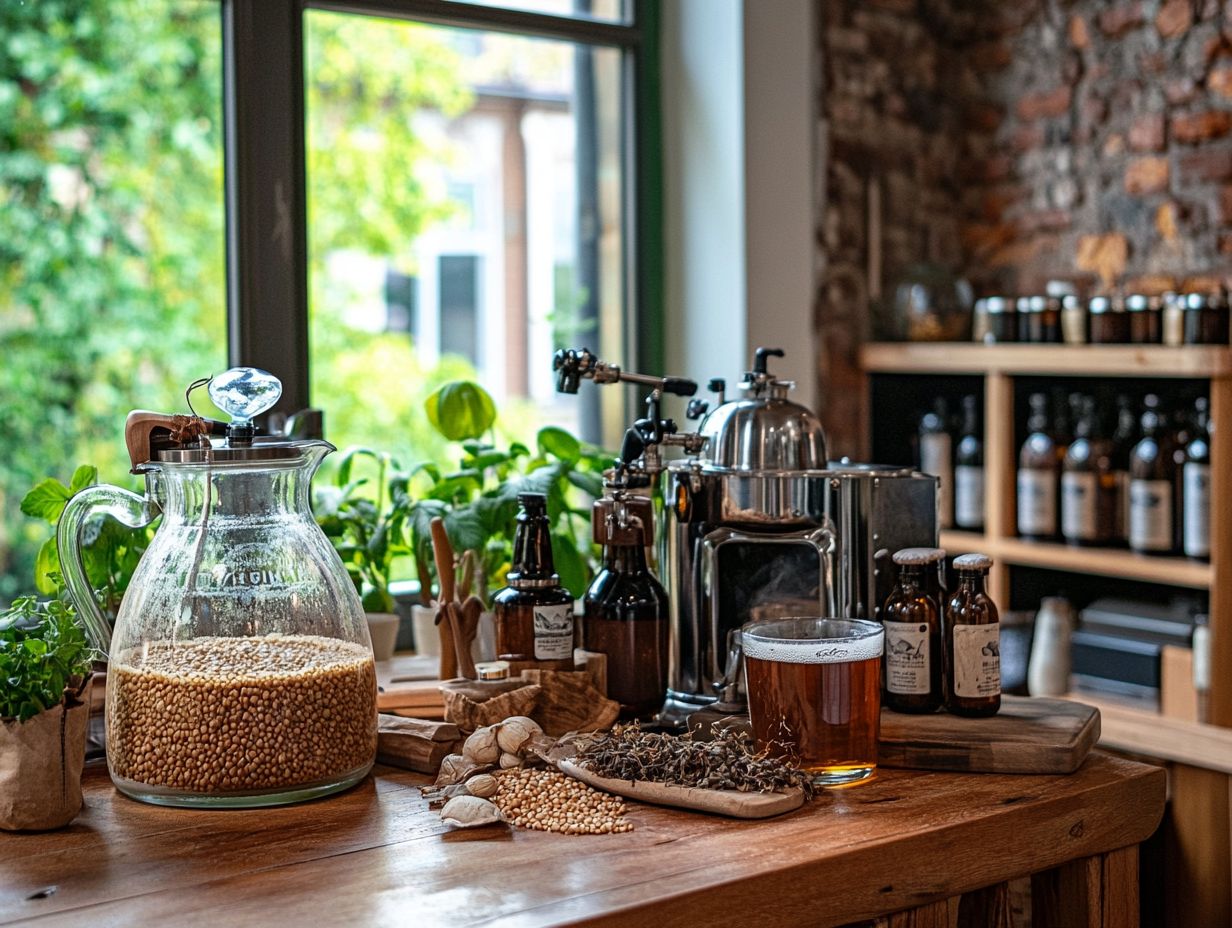
Regarding crafting your beer, selecting the right yeast is absolutely crucial. It plays a pivotal role in fermentation, flavor development, and the overall character of your brew.
Each yeast type is tailored for specific beer styles. Grasping their unique characteristics can enable you as a homebrewer to achieve the results you desire. Yeast does more than just convert sugars into alcohol; it also imparts distinctive flavors and aromas during fermentation.
Temperature and yeast health are key players in your brewing success. These factors influence everything from the beer’s aroma to its mouthfeel. Embrace this knowledge, and you ll elevate your brewing game.
1. Ale Yeast
Ale yeast is a top-fermenting yeast that flourishes at warmer fermentation temperatures, producing an impressive array of flavor profiles that define many traditional and craft beers.
This extraordinary yeast strain does more than just ferment sugars; it also enriches the aromatic complexity of your brew. Expect to encounter delightful fruity, spicy, and occasionally floral notes that can truly shape a beer s overall character.
Take IPAs, for example using ale yeast amplifies the hop-forward flavors, creating a harmonious balance of bitterness and sweetness that you won t want to miss.
Different styles of ales, including stouts and pale ales, thrive on this yeast’s knack for generating rich textures and mouthfeels, making them a favorite among craft beer aficionados. By understanding its impact, you enable yourself to create distinctive beverages that resonate with a wide audience.
2. Lager Yeast
Lager yeast is a bottom-fermenting wonder that thrives in cooler fermentation temperatures, crafting those clean and crisp beer styles you ve come to love, often with a delightful balance of subtle flavors.
This yeast strain, primarily Saccharomyces pastorianus, works its magic at temperatures typically ranging from 45 F to 55 F (7 C to 13 C). This slower approach is crucial, as it fosters the development of mild flavors while keeping those pesky esters fruity aromas and phenols spicy or medicinal flavors often found in ales at bay.
The influence of fermentation temperature is significant; it shapes the aromatic profile and mouthfeel of your final brew.
Frequently employed in beloved beer styles like Pilsners, Helles, and Dunkels, lager yeast is key to delivering that refreshing quality and smooth finish that beer enthusiasts savor.
Now that you understand yeast’s impact, it s time to experiment with different types in your next batch!
3. Specialty Yeast
Specialty yeast is your secret weapon in brewing. It imparts unique flavors and characteristics that elevate the complexity and diversity of craft beers.
These distinctive strains boast a wide range of fermentation profiles, making them crucial for crafting various beer styles. Take Belgian yeast strains, for instance; they’re celebrated for their ability to produce delightful fruity and spicy notes.
This makes them the go-to choice for beloved styles like Tripel and Saison. In contrast, lager yeast offers a cleaner profile but can be artfully modified to introduce diverse flavor nuances, perfect for brewing Helles or Pilsner.
For the adventurous, some craft brewers venture into the realm of wild yeasts, such as Brettanomyces, known for its funky flavors. This type of wild yeast is particularly popular in sour ales and barrel-aged creations.
Each of these specialty yeasts contributes a signature profile that enhances your overall drinking experience, transforming every sip into a delightful exploration.
What Factors Should You Consider When Creating a Beer Recipe?
When crafting a beer recipe, you’ll want to keep several essential factors in mind. This ensures that your final creation not only meets the desired style guidelines but also aligns with your personal taste preferences.
Understanding your target flavor profile is key. It will guide you in selecting the right ingredients like malt, hops, and yeast.
Establishing important parameters such as Alcohol by Volume (ABV) a measure of how strong your beer is and International Bitterness Units (IBU) a measure of how bitter a beer is early in the process is crucial.
These elements significantly influence the beer’s overall balance and character. Incorporate brewing tips like measuring original gravity and final gravity to refine your techniques and achieve the consistent results you desire.
1. Style Guidelines
Style guidelines act as your roadmap in the world of homebrewing. They help you craft beer recipes that align with the established characteristics of specific beer styles.
These guidelines do more than just outline ingredients; they shape your brewing techniques, fermentation processes, and even how you present your finished product.
By grasping these principles, you can elevate your brewing game, striking a harmonious balance between your creative flair and traditional methods.
Take, for example, the pale ale, which typically boasts a pronounced hop character alongside a moderate malt backbone. In contrast, a stout entices with its rich, dark flavors and velvety texture.
By familiarizing yourself with the distinctive attributes of various styles like the bold bitterness of IPAs or the refreshing tartness of sours you ll be better equipped to refine your skills.
2. Flavor Profile
The flavor profile of your beer is an important factor in your recipe development. It influences every ingredient choice, from malt to hops.
This essential aspect shapes the overall character and appeal of your final brew. It guides you in selecting specific malt types that enhance sweetness, color, and mouthfeel, while hops introduce bitterness, aroma, and complexity.
Your fermentation techniques, such as temperature control and yeast selection, can profoundly affect the flavor, adding delightful layers of fruity or floral notes.
As a passionate homebrewer, now is the time to explore unique tastes. Experimenting with unconventional ingredients like different grains, spices, or even fruit can yield extraordinary results.
This enables you to craft distinct brews that truly stand out in a crowded market. Embrace the adventure of brewing and let your creativity shine!
3. ABV (Alcohol by Volume)
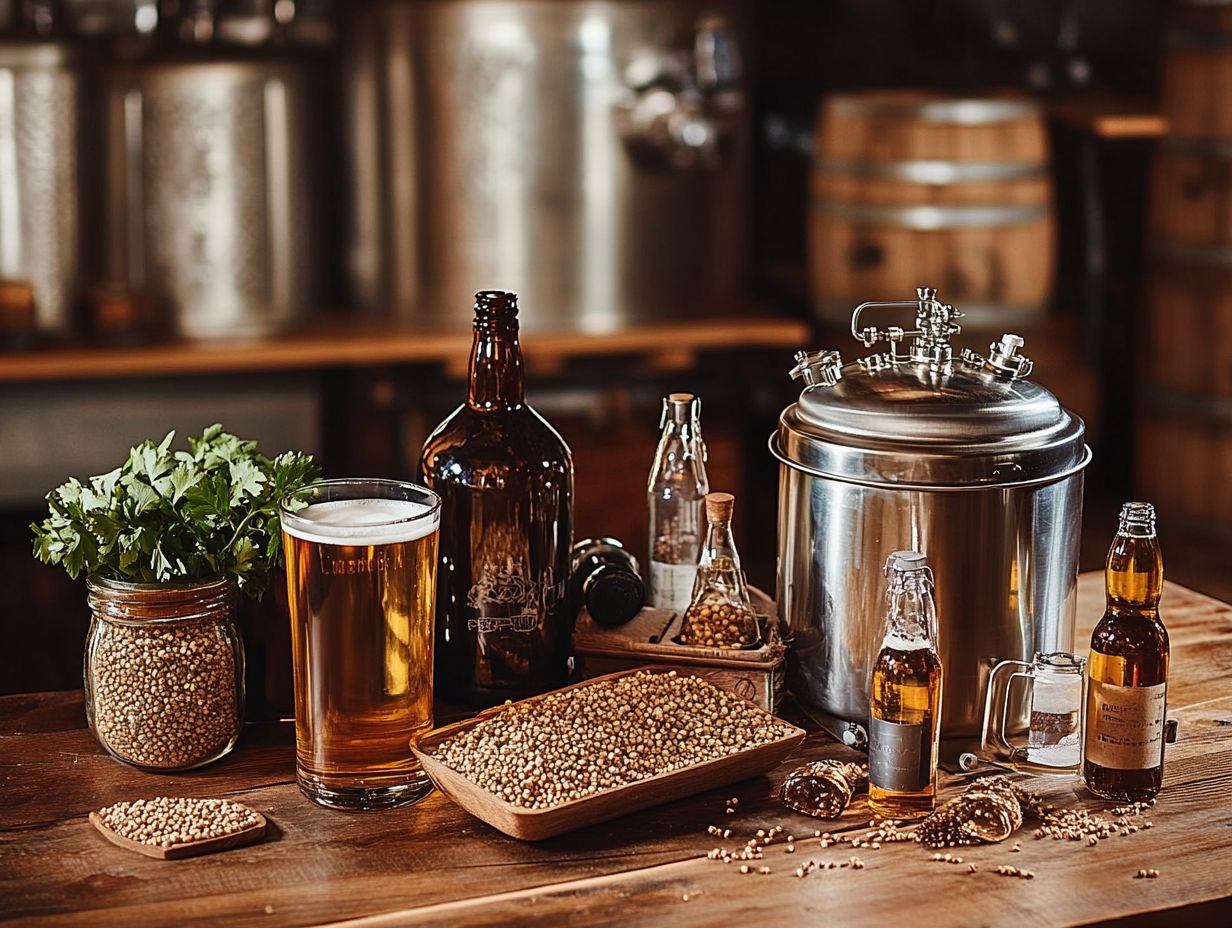
Alcohol by Volume (ABV) is a crucial metric in brewing that signifies the strength of your beer and is shaped by the fermentation process.
Understanding how to calculate ABV is essential for brewers. It helps refine recipes to achieve desired flavor profiles and meet consumer expectations.
The journey begins with measuring the original gravity (OG), which is a measure of the sugar in your beer before fermentation. Once fermentation wraps up, you’ll measure the final gravity (FG) to determine how much sugar remains after fermentation.
Calculating ABV is a straightforward process: simply subtract the FG from the OG and multiply the result by 131.25 to convert it into a percentage. This measurement reveals the alcohol content and plays a vital role in aligning your brew with various beer styles ranging from light lagers with lower ABV to robust stouts that boast higher levels.
Consumers often choose beers based on specific ABV ranges that match their flavor preferences, shaping their choices in a competitive market.
4. IBU (International Bitterness Units)
International Bitterness Units (IBU) serve as the definitive measure of a beer’s bitterness and are pivotal in achieving the perfect flavor balance in your recipes.
Grasping the concept of IBU is essential for both brewers and enthusiasts, as it significantly shapes the overall taste experience. A higher IBU signals a more pronounced bitterness, enriching the complexity of the beer’s flavors.
For homebrewers eager to customize their creations, adjusting the quantity and timing of hops during the brewing process can dramatically affect IBU levels. Introducing hops earlier in the boil extracts more bitterness, while later additions offer vibrant hop aroma and flavor with a gentler touch on bitterness.
This level of precise control enables you to craft a beer that aligns seamlessly with your preferred taste profile.
Frequently Asked Questions
What is the first step to creating my own beer recipe?
The first step to creating your own beer recipe is to decide what type of beer you want to make, such as a pale ale or stout.
What ingredients do I need to create my own beer recipe?
The main ingredients you will need are water, malted barley, hops, and yeast. You can also add additional ingredients for flavor, such as fruits or spices.
How do I determine the right ratios of ingredients for my beer recipe?
The ratios of ingredients will depend on the type of beer you want to make and personal preferences. Start with a basic recipe and adjust the ratios as you experiment and taste test.
Do I need any special equipment to create my own beer recipe?
While it is possible to make beer with basic kitchen equipment, having specialized equipment such as a brewing kettle and fermenter makes the process easier and more efficient.
How long does it take to create my own beer recipe?
Creating your beer recipe is a thrilling journey that typically takes 4-6 weeks from start to finish. This includes the brewing process, fermenting, and bottling or kegging.
Can I experiment with different ingredients in my beer recipe?
Absolutely! Part of the fun of creating your own beer recipe is experimenting with different ingredients and flavors. Just be sure to take good notes so you can replicate successful batches in the future.

